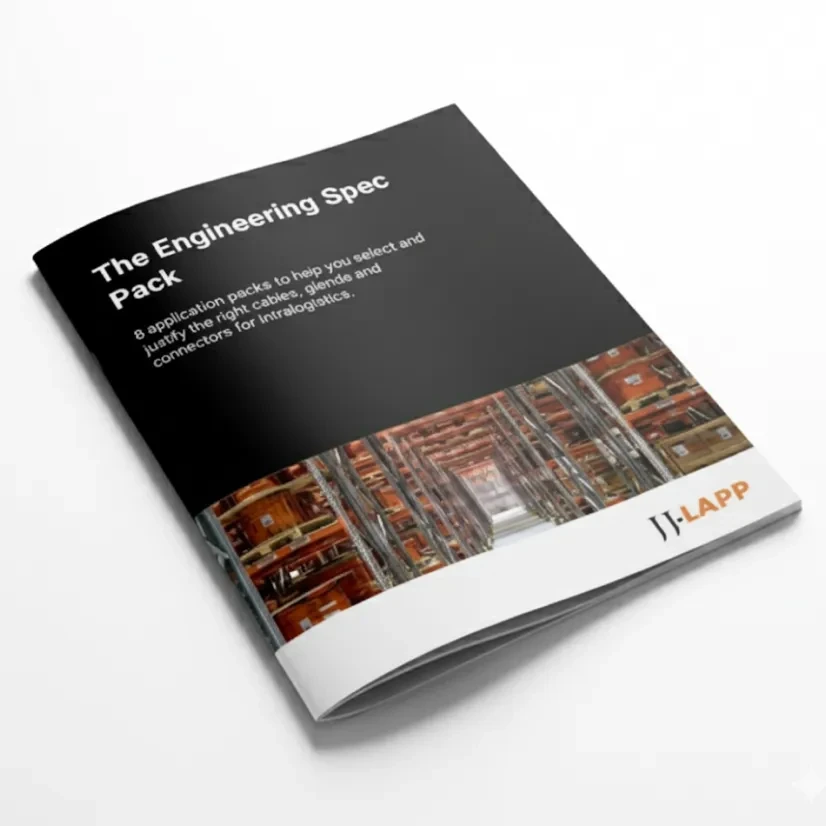Hybrid Power-Data Cables: Slimming High-Speed Shuttles & AMRs
How a Single, Motion-Rated Umbilical Sheds Kilos, Cuts Installation to Hours, and Extends Every Battery Charge in Southeast Asia’s Demanding Warehouses.
You’ve done everything to squeeze more speed from your automated systems. You’ve tuned every gram and chased every millisecond. Maybe you even managed another 0.2 m/s² out of your ASRS shuttle, only to see that gain disappear because the cables in its drag chain are simply too heavy.
Think about it: you have lightweight frames, hollow rails, and razor-thin circuit boards… but then you have two thick, heavy cables dragging behind—one for motor power, the other for data. That extra weight is a hidden performance killer.
This article explains how switching to a single hybrid power-data cable is a proven strategy for gaining a real competitive edge in your warehouse operations.
Why Cable Weight Matters for ASRS & AMR Performance
The warehouse automation market in Southeast Asia is booming, driven by the region’s e-commerce explosion. In this race for efficiency, aisles are getting narrower and the fastest machines are the lightest. Every extra gram of weight, especially from drag chain cables, becomes an energy tax that directly hits your bottom line.
- Higher Power Consumption: More weight means motors work harder and draw more current, running hotter—a significant issue in the already warm facilities across Southeast Asia.
- Shorter AMR Battery Life: For battery-powered AMRs, excess cable weight is a direct drain on their runtime, leading to more frequent and costly battery swaps. Lighter cabling is a key factor in extending operational range.
- Faster Wear and Tear: Heavier cables place more mechanical strain on their own jackets, the insulation, and the entire drag chain, leading to premature failure and costly downtime.
Often, the easiest place to find significant weight savings is hiding in plain sight: your ASRS and AMR cables.
The Clear Advantage: Hybrid Cable vs. Dual Cable Systems
What really happens when you replace two separate cables with one hybrid? The performance gains are immediate and measurable. Here’s a comparison based on typical LAPP product specifications for a 100-meter run in an ASRS shuttle:
| Metric (100m run, typical Ø25mm chain) | Dual Cables (Power + Data) | ÖLFLEX® CHAIN HYBRID | Improvement |
| Outer Diameter per Run | 15 mm + 8 mm | 14 mm total | Drastically less chain fill |
| Mass per Meter | ~340 g | ~230 g | Significantly lighter system |
| Potential Fault Points | 4 (Joints & Glands) | 2 (Joints & Glands) | Half the failure points |
Note: These figures are illustrative and based on a comparison of LAPP’s own technical datasheets. The “Dual Cables” figures represent a standard ÖLFLEX® power cable and an ETHERLINE® data cable. The “Hybrid” figures represent a specific ÖLFLEX® CHAIN HYBRID cable. Fault points are based on two connection points per cable.
A single hybrid cable dramatically reduces the space needed in your energy chain and makes the entire moving system significantly lighter.
Anatomy of a High-Performance Hybrid Cable
A true hybrid cable isn’t just two wires glued together. It’s an engineered system where every part has a purpose:
- One Tough Jacket (PUR): The outer shell is made from a highly durable, halogen-free polyurethane (PUR) that resists abrasion, industrial chemicals, and the high humidity common in Southeast Asia.
- Dedicated Power Cores: Inside, you have power conductors correctly sized for your 48V or 400V motors.
- Shielded Data Core: A high-speed data line (like Cat.5 for Profinet, 10 Gb/s Cat.6A for high-speed Ethernet, or Hiperface DSL) is packed alongside the power cores but is individually shielded to protect signal integrity from EMI.
- Optimised Grounding: A single, well-designed grounding path prevents the electrical “noise” that can occur with two separate shields, ensuring clean data transmission.
- Engineered for Extreme Motion: These motion-rated cables are built with fine Class 6 copper strands and tested for millions of bending and twisting cycles, making them essential for any component living inside a constantly moving machine.
The Performance Equation: How Lighter Cables Boost Throughput
Even shedding one kilogram from a typical ASRS shuttle can have a massive impact. A lighter shuttle could potentially complete a 40-meter run up to 200 milliseconds faster without any changes to the motor. Over 9,000 cycles a day, that could translate to an extra 30 minutes of productive time—all without new software or bigger motors.
For your battery-powered AMRs, less cable weight means longer operational shifts. It’s common in the industry to see every kilogram of weight saved extend battery life enough to potentially skip an entire battery swap per shift, which is a direct reduction in operating costs.
Simplify Installation with ÖLFLEX® CONNECT Ready-Made Harnesses
One of the biggest benefits is the ease of installation. JJ-LAPP delivers these hybrid cables as complete, pre-assembled ÖLFLEX® CONNECT harnesses, often built right here in the region.
- Factory Quality: You get a fully wired, sealed, and tested assembly, which eliminates common on-site wiring errors.
- Plug-and-Play: Instead of your team spending hours with crimp tools, they simply snap one labelled harness into place.
- Simplified Procurement: You order one part number, not a long list of separate cables, connectors, and glands.
This approach transforms a time-consuming installation task into a quick, error-proof process, getting your machines operational faster.
Your 5-Point Checklist for Specifying Hybrid Cables
Ready to make your automated systems more efficient? Here’s a simple checklist:
- Define Your Motion: Know the exact travel distance, bend radius, and torsional stress for each moving part.
- Match Power & Data: Specify the correct voltage and data protocol (e.g., Cat.5, Cat.6A, or Hiperface DSL) for your application.
- Don’t Overstuff the Chain: Aim for less than 60% fill in your cable chain. Hybrids make this easy.
- Use the Right Glands: Ensure your cable glands, like the SKINTOP® series available on our eShop, match the hybrid cable’s diameter and IP rating.
- Keep a “Hot Spare”: For every ten machines, keep one complete, pre-assembled hybrid harness ready for a lightning-fast swap-out.
Answering Common Questions About Hybrid Cables
- “Won’t the power lines interfere with the data?” Not in a properly engineered hybrid cable. The data core is specifically shielded to prevent electromagnetic interference (EMI), ensuring clean signals.
- “Doesn’t this complicate our spare parts inventory?” It actually simplifies it. You track one part number instead of two, purchase half the connectors, and manage a single warranty.
- “Long waits for parts from Europe kill our projects. How fast can JJ-LAPP get us these kits?” This is a key advantage of working with us. With local stock and assembly capabilities across Southeast Asia, JJ-LAPP can deliver these pre-assembled harnesses and hybrid cables to your site much faster, aligning with your project timelines.
The Bottom Line: Upgrading Your Cables is Upgrading Your Performance
In an environment where every pallet counts and cycle times equal revenue, your cables are no longer just “wiring.” They are a critical performance component.
Hybrid power-data cables deliver a clear trifecta of benefits:
- Less weight and space for faster, more energy-efficient automation.
- Dramatically faster installation with pre-assembled harnesses.
- Fewer potential points of failure and a simplified supply chain.
Ready to trim the fat and unlock the true speed of your automation? Let’s talk. Our local engineering teams in Southeast Asia can analyze your system, calculate the potential weight savings, and quote a plug-and-play harness you can install in minutes.


